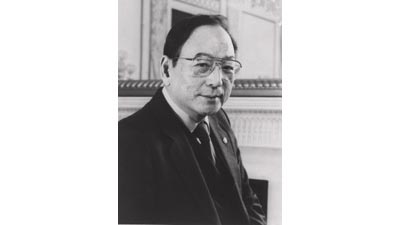The Senator from Hawaiiby Taylor Dinerman
|
| In a 1986 book, Matsunaga came up with a brilliant, idealistic, impractical, and visionary idea. He proposed that the US and the USSR join forces to send humans to Mars. |
As an unambiguously liberal Democrat, Matsunaga was an opponent of Ronald Reagan’s Strategic Defense Initiative (SDI), known as Star Wars. He was particularly against what he called “space weapons.” Unlike many opponents of the idea, however, he did not underestimate its powerful emotional appeal. He respected SDI’s supporters: “They were as fed up as I was with a suicidal process… The prevailing nuclear doctrine called MAD—mutually assured destruction—was mad indeed. Although opposed to a space weapons crash program, I deeply admire the willingness of its advocates to do new things; critics of SDI are often only negative.”
Senator Matsunaga identified the problem not as the weapons themselves but, like Ronald Reagan, who famously said, “We do distrust each other because we are armed, but we arm because we distrust each other,” he recognized that the problem was inherent in the conflict itself. He rejected arms control as a solution: “As weapons systems proliferated and grew ever more complex, arms control entered an ever deepening maze. How many Pershing 2s equal how many SS-20s? Did a Soviet ICBM in a hardened silo in the Ukraine equal a Poseidon missile in an American submarine in the North Atlantic? South Atlantic?”
“Along the way, the very nature of arms control changed. It was no longer merely a process—it had become a profession… Experts churned out reports, books, doctoral dissertations, learned articles, decipherable only by other maze dwellers or former maze dwellers, who had graduated to endowed chairs in maze analysis at prominent universities.”
Unlike Reagan, who wanted to radically change the whole nature of the struggle with the USSR, and thus to prevail, Matsunaga proposed doing away with the conflict almost altogether. He wanted to see “aggressive cooperation” to engage a younger generation of technologically savvy Soviet citizens in a joint mission of exploration. Actually, this was one part of Reagan’s overall policy that aimed at subverting Soviet power through people-to-people contacts.
| As the new Congress begins to take shape over the next few months, Senator Inouye has the chance to inject more of his old friend’s ideas into the policy making process. |
Possibly the most interesting proposal in the book was the one that would have taken manned space programs away from NASA and given them to the Air Force, restoring the “role of managing large scale expeditions of exploration, dating back in our country to the Lewis and Clark expedition of the eighteenth century.” The book The Mars Project: Journey’s Beyond the Cold War was published just as that conflict was coming to an end. As the Soviet Union collapsed, many of Matsunaga’s ideas were picked up and adapted by both the George H.W. Bush and Clinton administrations. The International Space Station may not exactly be what the Senator had in mind, but the fact that it is largely a US-Russian project owes much to the set of ideas he brought to Washington.
As the new Congress begins to take shape over the next few months, Senator Inouye has the chance to inject more of his old friend’s ideas into the policy making process. For example, Matsunaga was ahead of his time in seeing the need to track and catalog all the asteroids that might hit Earth. The committee might want to hold hearings on the subject of planetary protection. The late Senator not only saw the need to protect this planet, but he also wrote that the “…process leads naturally to unmanned reconnaissance missions, culminating eventually in space mining and manufacturing.”
Senator Matsunaga was able to put together bipartisan alliances in support of some of his space policy proposals. It will be a good sign if, in his new position as ranking Democrat on the committee, Inouye were to make the same kind of effort. Many of the issues that were at the center of political life in 1986 are no longer relevant, but the sad fact that no human has escaped from Earth orbit since 1972 is still true. The potential for a successful partnership is there. Already, one Hawaiian Democrat has pushed US space policy in the direction of Mars and beyond. Now, there is the chance for another to continue the project.
